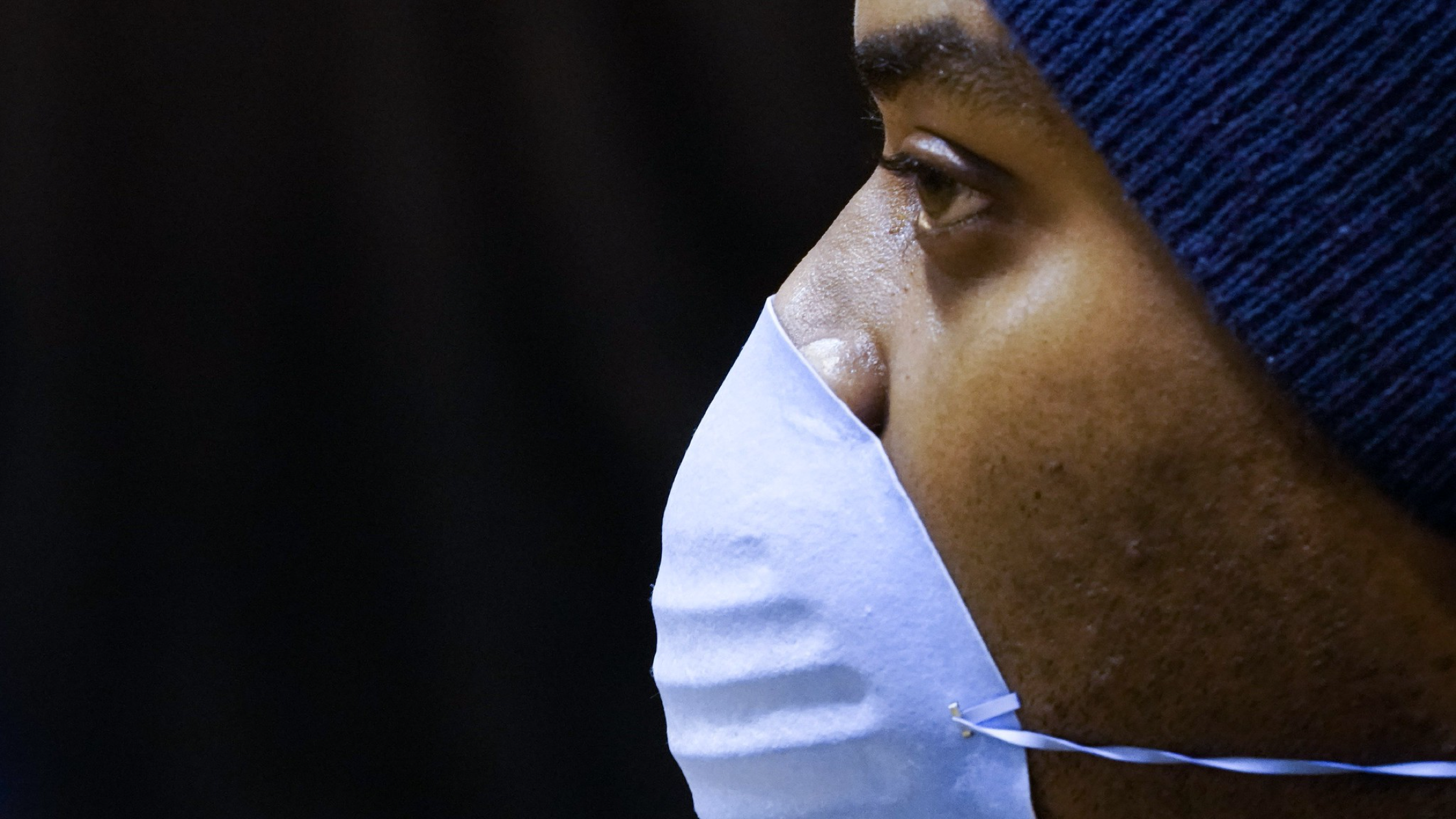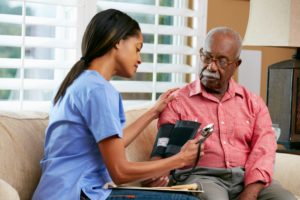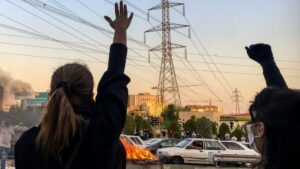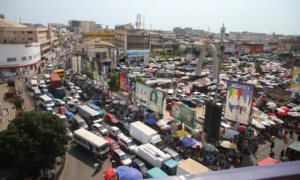Race explains why cities across the country are seeing a disproportionate amount of black deaths
Adrienne Lathan figured she had a cold.
On March 16, the 48-year-old started to feel sick just days after her 7-year-old grandson, Terrence Lathan Jr., began exhibiting symptoms of a cold.
But after three days, Lathan, a technology support technician for Milwaukee Public Schools, was concerned. As an asthma patient and someone who had been watching the news about the burgeoning coronavirus, she began to worry this “cold” wasn’t really a cold. She called her doctor at Ascension Columbia St. Mary’s Hospital to make sure.
The doctor told her to self-quarantine for seven days at her home on the city’s northwest side, which she shares with her grandson, his father, Terrence Lathan Sr., and a female cousin, and to reach out again if her symptoms got worse.
Over the next five days, the high fever (102 degrees), body aches, headaches, dry coughs, congestion, shortness of breath and painful diarrhea continued. None of the treatments seemed to work. NyQuil. DayQuil. Tylenol. Theraflu. Nothing.
After visiting a drive-thru testing center (the first of three times she would be tested over the next month), Lathan tested positive for the coronavirus on March 27. She was admitted to Columbia St. Mary’s on March 31.
At the hospital, the symptoms persisted. Lathan had problems catching her breath. She had to keep the lights off in her room because they hurt her eyes. She kept the room’s television off because it kept showing coronavirus coverage. An X-ray showed she had pneumonia in both lungs. The stress and anxiety caused her blood pressure to rise.
One day she woke up and a response team was standing around her bed.
“They actually thought they lost me,” she said.
A stark picture for African Americans
In the middle of a pandemic that has touched all but one continent, Milwaukee has emerged as a leading example of how the coronavirus, and COVID-19, the disease caused by the virus, has disproportionately affected African Americans.
The Centers for Disease Control and Prevention (CDC) has found that African Americans, who account for 13% of the U.S. population, make up 31% of coronavirus hospitalizations. A Washington Post analysis of state health department data also found that “counties that are majority-black have three times the rate of infections and almost six times the rate of deaths as counties where white residents are in the majority.”
In Wisconsin, black people make up 6.7% of the state population, but make up 24% of all coronavirus cases and 35% of coronavirus-related deaths. In Milwaukee County, where African Americans make up 27% of the population, African Americans make up 42% of positive cases and 52% of coronavirus-related deaths. The rate of coronavirus cases (positive tests per 100,000 people) in Milwaukee County stands at 275.5, by far the highest rate in the state.
Milwaukee’s notorious history as one of the most segregated cities in America, combined with a history of inadequate health care, housing and government action, has made the industrial city of 600,000 a test case of how black Americans are being exposed to and dying from a disease that New York Gov. Andrew Cuomo and others once referred to as “the great equalizer.”
To be sure, Milwaukee is not unique among major U.S. cities. In Detroit, New Orleans, Chicago and Washington, African Americans comprise the majority of COVID-19 deaths despite not accounting for a majority of the population in their respective cities. In New York City, African Americans are twice as likely to die from COVID-19 as white residents in the city.
In early April, the CDC released a report on COVID-19 hospitalizations from March 1 to March 30, which showed that of a sample of 180 adults who tested positive for the coronavirus, 90% had a preexisting health condition. Those top five conditions were hypertension, obesity, chronic metabolic disease (e.g., diabetes), chronic lung disease (e.g., asthma) and cardiovascular disease (e.g., coronary artery disease, congestive heart failure).
A look at those underlying conditions paints a dismal picture for African Americans.
According to the U.S. Department of Health and Human Services, African Americans are 40% more likely to have high blood pressure than white Americans; 1.3 times more likely to be obese (about four out of five black women are obese); 60% more likely to be diagnosed with diabetes; and, at one point, were almost three times more likely to die from “asthma-related causes.” Nearly half of all African American men and women have some form of heart disease, according to the American Heart Association.
“This virus obviously affects people who have significant comorbid conditions more than those who do not. I can tell you, clinically, it loves to particularly affect people that are obese,” Marc J. Labat, an emergency medicine doctor at St. Charles Parish Hospital in Louisiana, told The Undefeated last week. “The reality of the matter is that we know that African Americans are 50% more likely to be obese than their non-Hispanic white counterparts.”
Researchers at Harvard University’s T.H. Chan School of Public Health also recently found that long-term exposure to air pollution can possibly lead to higher rates of deaths from COVID-19. A 2019 study in the Proceedings of the National Academy of Sciences of the United States of America found that, on average, African Americans are exposed to 56% more air pollution than they themselves cause, air pollution that is disproportionately caused by white Americans. White people, on the other hand, are exposed to 17% less of the air pollution they’re responsible for.
Then there’s the issue of health care.
The issues with health care
Black susceptibility to the coronavirus starts with access to (affordable) health care. In short, access is limited. Before the passage of the Affordable Care Act (ACA) in 2010, uninsured rates for non-elderly African Americans were at 20%, the second-highest rate in the country behind Hispanics. While the ACA raised insured rates among all racial groups in America, the current uninsured rates for African Americans (9.9%), regardless of age, is more than that of white Americans (5.9%).
Even if black Milwaukeeans have access to health care, that may not be their reality. Across the country, African Americans are more likely than white Americans to live in a neighborhood with a shortage of hospitals and doctors. A 2014 joint analysis by the Pittsburgh Post-Gazette and Milwaukee Journal Sentinel found that while nearly two-thirds of hospitals opened in the U.S. since 2000 have been in wealthy suburban neighborhoods, poor urban communities have lost 46% of their hospitals in the same time span. (“Since 1988, Milwaukee County has lost its public hospital and five city hospitals,” the report found.) In 2018, Ascension, one of the largest private health care providers in the country (which operates Columbia St. Mary’s), shut down surgical and medical units at its St. Joseph hospital in Milwaukee due to financial constraints. By sure coincidence, most St. Joseph patients are covered by Medicaid, the federal health care program for low-income people (African Americans account for 20% of Medicaid enrollees nationally).
As it pertains to the coronavirus, African Americans are having a hard time even getting tested. In Milwaukee, Lathan said people were shocked at how fast she was able to get tested. But Philadelphia paints a different picture.
Usama Bilal, an assistant epidemiology and biostatistics professor at Drexel University’s Dornsife School of Public Health, using ZIP code data from the Philadelphia Department of Public Health, found that, per capita, people living in poorer ZIP codes in Philadelphia are being tested six times less for the coronavirus than those living in ZIP codes in wealthier neighborhoods.
Bilal found that, in the four least tested ZIP codes in Philadelphia, African Americans make up 24.4%, 50%, 37% and 15.8% of the population. In the top four tested ZIP codes, African Americans make up 7.9%, 29.2%, 42.7% and 4.5% of the population. (Gentrification and white wealth, Bilal says, explain why the ZIP code 19146, where African Americans make up 42.7% of the population, has a high test rate.)
While “poor” and “black” are not synonymous, Bilal said, one can extrapolate this class data to race to get a clearer picture of who is being excluded in testing.
“Those two things, unfortunately due to racism and all of that, are highly linked, especially in Philadelphia,” Bilal said, referring to class and race. “It is hard to separate those two in this case.”
Testing and tracing are key to controlling the coronavirus, he added. Which brings as no surprise that black Philadelphians make up the most coronavirus-related deaths in the city. Data released Wednesday by the city’s Department of Public Health shows that black Philadelphians made up 39% of 78 deaths resulting from COVID-19. White Philadelphians comprised another 29%.
Overcoming physical access concerns doesn’t necessarily lead to adequate care: African Americans receive by far the worst medical care in the country, no doubt compounded by long-held racist stereotypes perpetuated by some medical professionals.
A 2016 study published in the Proceedings of the National Academy of Sciences of the United States of America found that half of a sample of white medical students believed in one or more “false beliefs” in biological differences between African Americans and white Americans (e.g. “Blacks’ skin is thicker than whites”). In normal times, unconscious biases could lead to inadequate care or unsettling microaggressions. In the era of COVID-19, unconscious biases could be the difference between life and death.
In Detroit, Gary Fowler, a 56-year-old black man, died days after being sent home by three metro hospitals despite exhibiting symptoms of the coronavirus: difficulty breathing, high fever and exposure to someone who tested positive for COVID-19. “I just felt so bad because he was begging for his life, and medical professionals did nothing for him,” Keith Gambrell, Fowler’s son, told the Detroit Free Press.
Back in Milwaukee, Syvell Hall, a 53-year-old assistant principal at James E. Groppi High School, was discharged from a hospital despite having already tested positive for COVID-19. Hall said an emergency room physician’s assistant told him that he should come back if his symptoms (dizziness, nausea, headache, high temperature) worsened. This comes months after a Milwaukee woman, in an incident unrelated to the coronavirus pandemic, died after waiting two hours in a hospital waiting room after exhibiting chest pain and shortness of breath.
“I felt like the level of care, as it related to my suffering, wasn’t being taken seriously. I didn’t feel like I had any rights to question their authority,” Hall told the Milwaukee Journal Sentinel.
The long, sordid history of the health care industry’s treatment of African Americans — from the Tuskegee Study of Untreated Syphilis in the Negro Male to the theft of Henrietta Lacks’ cancer cells — has also contributed to substandard health. A 2007 study in the National Center for Biotechnology Information found that African Americans were distrustful of clinical research and less likely than white Americans to trust doctors when it comes to medical research, severely impacting the participation of African Americans in studies. A 2017 working paper in the National Bureau of Economic Research found a correlation between the exposure of the Tuskegee experiments in 1972 and the increase in medical mistrust and decrease in doctor visits among black men.
“I can’t tell you the numbers of people that I have known of who have shown up in the emergency room the last week of their lives with cancer because they didn’t have any insurance or didn’t have any money and didn’t want to go seek health care,” said Rep. Gwen Moore, whose congressional district covers the city of Milwaukee.
“It’s not because we have some sort of ‘black gene’ that makes us more susceptible to morbidity — we are responsible. We’re maimed in all kinds of ways, cut, injured … and we just don’t show up. And when we do show up, there are all kinds of other impediments.”
‘Social distancing is a privilege’
To help prevent the spread of the virus, Americans have been advised to practice social distancing, limiting the number of people they are around and breaking up large gatherings. Social distancing and stay-at-home orders have likely saved millions of lives in America alone.
But as New York Times op-ed columnist Charles M. Blow recently wrote, “social distancing is a privilege.” Stay-at-home directives from state governments have kept some 300 million people indoors, but there’s reason to believe many African Americans are among the crop of workers deemed “essential” by state and federal governments, thus having few other options than to risk their health and go to work.
Most black workers can’t social distance. According to the U.S. Bureau of Labor Statistics data reviewed by the Economic Policy Institute, a Washington-based nonpartisan think tank, while 30% of white Americans and 37% of Asian Americans work in industries that allow for telework, less than 20% of black people do. The data also shows that those who work jobs with the lowest wages in the country (hospitality, transportation, retail, construction) — jobs with the largest concentrations of black workers — are less likely to be able to work from home.
Black workers find it difficult to social distance while on their way to work. A 2006 study by researchers at the University of California, Berkeley and Brookings Institution Metropolitan Policy Program found that African Americans had the lowest car ownership in America, a rate four times less than that of white Americans. Which explains why African Americans are most likely to use public transportation, according to a 2015 Pew Research Center survey. And there’s a high chance the person funneling people to their jobs on public transportation are, themselves, black: Public data website Data USA found that nearly 30% of bus drivers in America are black. African Americans also over indexed among ride-share drivers: a 2014 Benenson Strategy Group survey found that nearly 20% of Uber drivers in 20 major cities were black (40% were white).
Related Story
Black people were stressed before the coronavirus — now more than ever we need to ask for help
Social distancing is almost nonexistent among the homeless population, which in Milwaukee is overwhelmingly black. A point-in-time study of homelessness in Milwaukee by the Institute for Community Alliances, a nonprofit group that addresses “housing instability, homelessness, food insecurity,” found that nearly 60% of the homeless population in the city and county was black.
Fred Royal, president of the Milwaukee chapter of the NAACP, said he is concerned about the city’s vulnerable population that have either been turned away from testing or have nowhere to go if they test positive.
“Where’s the effort to ensure that the individuals who are homeless in the city of Milwaukee or have housing issues … have access to these types of facilities where they can self-quarantine if they’ve been identified with COVID-19?” asked Royal, who has lost five friends and relatives to the disease.
When asked if he believes that there’s a high percentage of African Americans being sent away from hospitals while seeking COVID-19 testing, Royal responded, “Anecdotally, I believe that would be accurate.”
Shortages of paper towels and toilet tissue aside, some black people in Milwaukee don’t have the privilege of raiding grocery stores and hunkering down for weeks in their homes. Milwaukee is one of the most impoverished cities in the country; in 2014, Milwaukee’s poverty rate (29%) was double the national rate (14.8%). Seventy percent of the city’s 52 food pantries have closed since March. In one neighborhood, Sherman Park, just one food pantry remains out of four and there are zero grocery stores. Residents told The Washington Postthey’ve been forced to travel from these food deserts — whether by car or public bus — to white neighborhoods miles away in order to find stocked grocery stores.
Sherrie Tussler, executive director of the Hunger Task Force, a nonprofit food bank that provides food for low-income people in Milwaukee, said years of neglect of certain neighborhoods in the city have helped further devastate these communities during the pandemic. In the 53206 ZIP code, which is situated in the northwest area of the city and is 94% black, houses are boarded up, businesses have left, and coffee shops and libraries are nonexistent.
“That neighborhood, in particular, you’re just super aware of everything going on around you because it just doesn’t feel right,” said Tussler, who added that her organization would have gone broke by now had it not been for timely donations.
While African Americans in Milwaukee suffer, it appears some white people in the state couldn’t care less. A Wisconsin conservative radio host, using “Milwaukee” as a euphemism for “black,” told The New York Times the state should be reopened because when “You go to central and northern Wisconsin, you have folks who are looking at Milwaukee and saying, ‘We understand that they need help, but why do we have to sacrifice our entire livelihood for them?’ ” The treasurer of the Republican Party of Wisconsin implored his followers to leave their Confederate flags at home for a protest in Madison, Wisconsin, against the governor’s extension of a stay-at-home directive as to “control the optics during the event.” Most protesters at demonstrations across the country have been white.
While multiple surveys show that most Americans support stay-at-home or social distancing measures to help prevent the spread of the virus — which has infected more than 1 million Americans and killed more than 55,000 in less than two months, including 167 people in Milwaukee County as of April 18 — a Pew Research study found that African Americans (and Hispanics) are more concerned than white Americans about either contracting the coronavirus or unknowingly spreading it to others.
“This right here, I wouldn’t wish this on my worst enemy,” said 53-year-old Michelle Hudson, who lives in Milwaukee and tested positive for COVID-19 in early April.
“Everybody just needs to — excuse my French — sit they a–es down until this is over.”
‘This is killing people’
On March 28, Lathan posted on her Facebook page that she had tested positive for the coronavirus and implored her friends to “Please, please, please believe me when I say this is SERIOUS & REAL!” The response she received was “very therapeutic,” she said.
“HE got you Adrienne,” one woman wrote, presumably referring to God.
“I believe that your telling others will finally make it real for some folks who are still taking this lightly,” another said.
Nearly 700 people commented on the status. Another 126 shared it.
On March 31, after six days in the hospital, Lathan was discharged. “YES! I am home & I’m a COVID-19 SURVIVOR!” she wrote on Facebook.
The jubilation was fleeting, though. At the bottom of her post about leaving the hospital, Lathan added a note: “PLEASE keep my dad, Jerald, in your thoughts & prayers. He’s in ICU fighting for his life.”
A day before Lathan was released from Columbia St. Mary’s, her 71-year-old father, Jerald Coleman, was admitted to St. Joseph. A retired laborer and Vietnam war veteran, Coleman had battled diabetes, congestive heart failure and hypertension throughout his life.
On April 4, Coleman died. A week before he had tested positive for COVID-19.
Lathan feels survivor’s guilt. Why did she make it but her father didn’t? On top of that, her close friend also died from COVID-19 on April 13. Another friend is currently in a hospital’s intensive care unit battling the disease.
Despite testing negative for the virus in late April, it still lingers, at least psychologically. Grocery shopping is a nerve-racking experience. A trip to a respiratory clinic led to her heart racing as she contemplated getting out of the car. What motivated her during that week in the hospital was getting back to her son and grandson.
“This is the face of a survivor. If you want to be a survivor, you have to take this seriously,” said Lathan, who is well-aware of the disparity between how the virus has impacted black and white communities.
“This is not a joke. This is not a common cold. This is killing people.”




